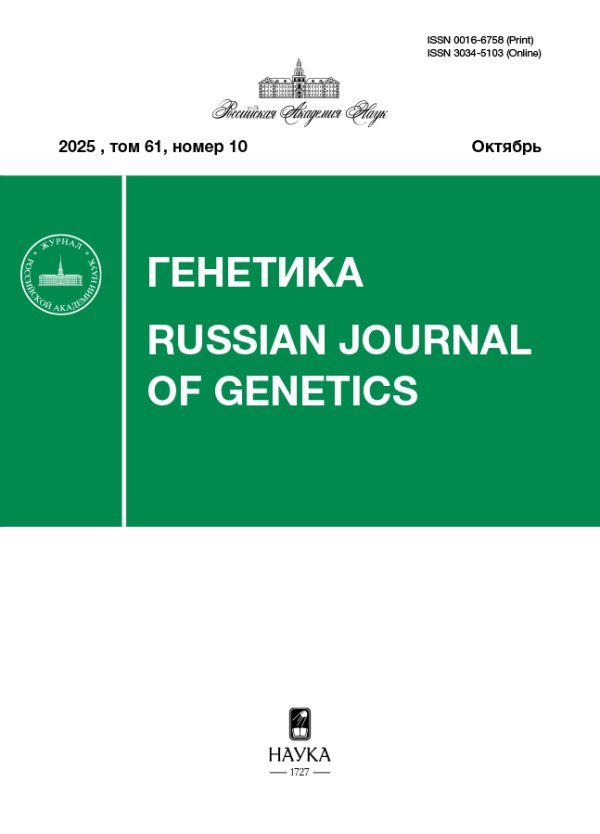Ассоциация полиморфизма VNTR гена AS3MT с риском развития шизофрении
- Авторы: Коровайцева Г.И.1, Лежейко Т.В.1, Олейчик И.В.1, Голимбет В.Е.1
-
Учреждения:
- Научный центр психического здоровья
- Выпуск: Том 59, № 4 (2023)
- Страницы: 481-486
- Раздел: КРАТКИЕ СООБЩЕНИЯ
- URL: https://journals.rcsi.science/0016-6758/article/view/134582
- DOI: https://doi.org/10.31857/S0016675823040045
- EDN: https://elibrary.ru/AVFLVA
- ID: 134582
Цитировать
Полный текст
Аннотация
Ген AS3MT кодирует метилтрансферазу мышьяка(III). VNTR-полиморфизм гена AS3MT, характерен только для генома человека и связан с экспрессией специфичной для человека изоформы белка AS3MTd2d3, которая является потенциальным фактором риска развития шизофрении. Нами проведен анализ распределения частот аллелей и генотипов полиморфизма VNTR на большой выборке этнических русских. Изучена ассоциация VNTR с риском развития шизофрении. Анализ проводили на выборке, включающей в себя 1002 больных шизофренией и расстройствами шизофренического спектра и 1510 человек контрольной группы. Обнаружено, что у женщин, носителей генотипа V3/V3, риск развития шизофрении увеличивается (ОШ = 1.4, 95% ДИ: 1.11–1.77).
Ключевые слова
Об авторах
Г. И. Коровайцева
Научный центр психического здоровья
Автор, ответственный за переписку.
Email: korovaitseva@mail.ru
Россия, 115522, Москва
Т. В. Лежейко
Научный центр психического здоровья
Email: golimbet@mail.ru
Россия, 115522, Москва
И. В. Олейчик
Научный центр психического здоровья
Email: golimbet@mail.ru
Россия, 115522, Москва
В. Е. Голимбет
Научный центр психического здоровья
Автор, ответственный за переписку.
Email: golimbet@mail.ru
Россия, 115522, Москва
Список литературы
- Riley B., Kendler K.S. Molecular genetic studies of schizophrenia // Eur. J. Hum. Genet. 2006. V. 14. № 6. P. 669–680. https://doi.org/10.1038/sj.ejhg.5201571
- Marder S.R., Cannon T.D. Schizophrenia. // N. Engl. J. Med. 2019. V. 381. № 18. P. 1753–1761. https://doi.org/10.1056/NEJMra1808803
- Schizophrenia Working Group of the Psychiatric Genomics Consortium. Biological insights from 108 schizophrenia-associated genetic loci // Nature. 2014. V. 511. P. 421–427. https://doi.org/10.1038/nature13595
- Lam M., Chen C.Y., Li Z. et al. Comparative genetic architectures of schizophrenia in East Asian and European populations // Nat. Genet. 2019. V. 51. № 12. P. 1670–1678. https://doi.org/10.1038/s41588-019-0512-x
- Jaffe A.E., Straub R.E., Shin J.H. et al. Developmental and genetic regulation of the human cortex transcriptome illuminate schizophrenia pathogenesis // Nat. Neurosci. 2018. V. 21. № 8. P. 1117–1125. https://doi.org/10.1038/s41593-018-0197-y
- Takata A., Matsumoto N., Kato T. Genome-wide identification of splicing QTLs in the human brain and their enrichment among schizophrenia-associated loci // Nat. Commun. 2017. V. 8. P. 14519–14529. https://doi.org/10.1038/ncomms14519
- Huo Y., Li S., Liu J. et al. Functional genomics reveal gene regulatory mechanisms underlying schizophrenia risk // Nat. Commun. 2019. V. 10. № 1. P. 670–688. https://doi.org/10.1038/s41467-019-08666-4
- Li M., Jaffe A.E., Straub R.E. et al. A human-specific AS3MT isoform and BORCS7 are molecular risk factors in the 10q24.32 schizophrenia-associated locus // Nat. Med. 2016. V. 22. № 6. P. 649–656. https://doi.org/10.1038/nm.4096
- Schizophrenia Working Group of the Psychiatric Genomics Consortium, Ripke S., Walters J.T., O’Donovan M.C. Mapping genomic loci prioritises genes and implicates synaptic biology in schizophrenia // MedRxiv. 2020.09.12. https://doi.org/10.1101/2020.09.12.20192922
- Trubetskoy V., Pardiñas A.F., Qi T. et al. Mapping genomic loci implicates genes and synaptic biology in schizophrenia // Nature. 2022. Apr 8. https://doi.org/10.1038/s41586-022-04434-5
- Li L., Chang H., Huang T. et al. Recent positive selection drives the expansion of a schizophrenia-associated variant within 10q24.33 in human populations through its pleiotropic effects on diverse human complex traits // J. Psychiatry Brain Sci. 2017. V. 2. № 1. P. 1–17. https://doi.org/10.20900/jpbs.20170001
- Yu H., Yan H., Li J. et al. Common variants on 2p16.1, 6p22.1 and 10q24.32 are associated with schizophrenia in Han Chinese population // Mol. Psychiatry. 2017. V. 22. № 7. P. 954–960. https://doi.org/10.1038/mp.2016.212
- Xiao X., Luo X.J., Chang H. et al. Evaluation of European schizophrenia GWAS loci in Asian populations via comprehensive meta-analyses // Mol. Neurobiol. 2017. V. 54. № 6. P. 4071–4080. https://doi.org/10.1007/s12035-016-9990-3
- Duarte R.R.R., Troakes C., Nolan M. et al. Genome-wide significant schizophrenia risk variation on chromosome 10q24 is associated with altered cis-regulation of BORCS7, AS3MT, and NT5C2 in the human brain // Am. J. Med. Genet. (part B Neuropsychiatr. Genet). 2016. V. 171. № 6. P. 806–814. https://doi.org/10.1002/ajmg.b.32445
- Guan F., Zhang T., Li L. et al. Two-stage replication of previous genome-wide association studies of AS3MT-CNNM2-NT5C2 gene cluster region in a large schizophrenia case-control sample from Han Chinese population // Schizophrenia Research. 2016. V. 176. P. 125–130. https://doi.org/10.1016/j.schres.2016.07.004
- Cai X., Yang Z.H., Li H.J. et al. A human-specific schizophrenia risk tandem repeat affects alternative splicing of a human-unique isoform AS3MTd2d3 and mushroom dendritic spine density // Schizophr. Bull. 2021. V. 47. № 1. P. 219–227. https://doi.org/10.1093/schbul/sbaa098
- Zhao W., Zhang Q., Chen X. et al. The VNTR of the AS3MT gene is associated with brain activations during a memory span task and their training-induced plasticity // Psychol. Med. 2021. V. 51. № 11. P. 1927–1932. https://doi.org/10.1017/S0033291720000720
- Wood T.C., Salavagionne O.E., Mukherjee B. et al. Human arsenic methyltransferase (AS3MT) pharmacogenetics: gene resequencing and functional genomics studies // J. Biol. Chem. 2006. V. 281. № 11. P. 7364–7373. https://doi.org/10.1074/jbc.M512227200
- Li X., Xiao Y., Zhao Q. et al. The neuroplastic effect of working memory training in healthy volunteers and patients with schizophrenia: Implications for cognitive rehabilitation // Neuropsychologia. 2015. V. 75. P. 149–162. https://doi.org/10.1016/j.neuropsychologia.2015.05.029
- Thermenos H.W., Keshavan M.S., Juelich R.J. et al. A review of neuroimaging studies of young relatives of individuals with schizophrenia: a developmental perspective from schizotaxia to schizophrenia // Am. J. Med. Genet. (part B Neuropsychiatr Genet). 2013. V. 162. № 7. P. 604–635. https://doi.org/10.1002/ajmg.b.32170
- Berry K.P., Nedivi E. Spine dynamics: Are they all the same? // Neuron. 2017. V. 96. № 1. P. 43–55. https://doi.org/10.1016/j.neuron.2017.08.008
- Korovaitseva G.I., Gabaeva M.V., Yunilainen O.A., Golimbet V.E. Effect of VNTR polymorphism of the AS3MT gene and obstetrical complications on the severity of schizophrenia // Bull. Exp. Biol. Med. 2019. V. 168. № 1. P. 84–86. https://doi.org/10.1007/s10517-019-04653-3
Дополнительные файлы










